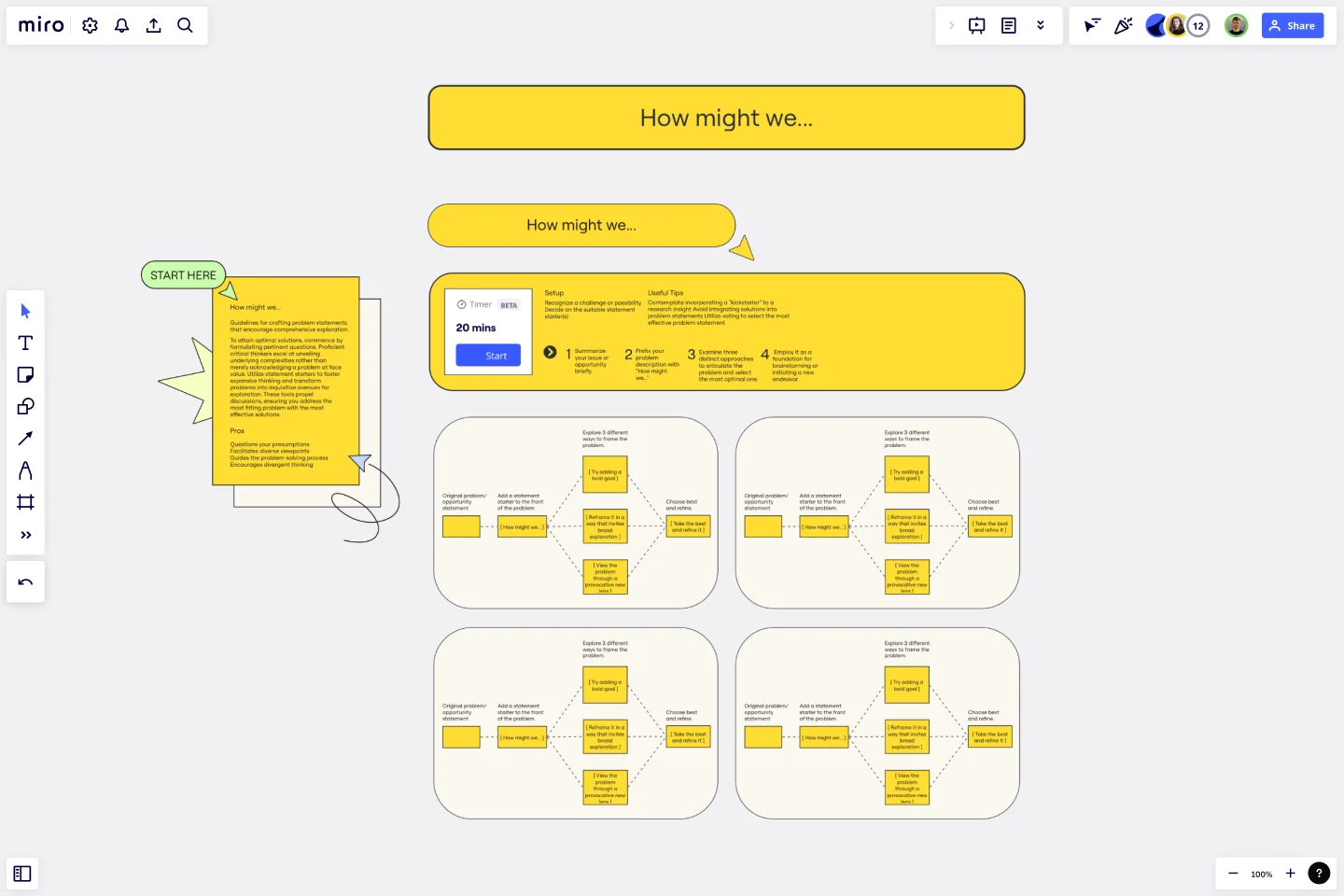How Might We Template
Craft problem statements encouraging comprehensive exploration with the How Might We Template.
About the How Might We Template
To find the most effective solutions to problems, it's important to start by asking the right questions. This is where the How Might We Template comes in handy. It's a statement starter that encourages comprehensive exploration of problems. Using this template, you can break down complex problems into smaller, more manageable parts, which can help you identify the root cause of the problem.
Critical thinking is a key skill that can help you uncover the underlying complexities of a problem. Instead of just accepting a problem at face value, skilled critical thinkers can dig deeper and identify the underlying issues contributing to the problem. This type of thinking is essential for finding the most effective solutions.
Statement starters like the How Might We Template can help you explore more open-ended problems. These tools allow you to approach problems from different angles and consider a wider range of potential solutions. By doing so, you can have more productive discussions and ultimately find the most effective solutions to your problems.
Benefits of using the template
Question your presumptions.
Facilitate diverse viewpoints.
Guide the problem-solving process.
Encourage divergent thinking.
How to use the template in Miro
Summarize your issue or opportunity briefly.
Prefix your problem description with "How might we...”
Examine three distinct approaches to articulate the problem and select the most optimal one.
Employ it as a foundation for brainstorming or initiating a new endeavor.
Setup
Recognize a challenge or possibility.
Decide on the suitable statement starter(s).
Useful tips
Contemplate incorporating a "kickstarter" to a research insight.
Avoid integrating solutions into problem statements.
Utilize voting to select the most effective problem statement.
Get started with this template right now.
Co-Creation Template
Works best for:
Design
The Co-Creation Template enables the visual expression of ideas using essential elements. Analysis of these creations identifies explicit and implicit needs. For instance, a human resources team may use symbols to envision their ideal work environment. The output reflects people's desires and expectations.
Tell a Great Story
Works best for:
Storyboard
Tell a great story with the Storyboard template. Visualize your narrative using images, notes, and descriptions to map out each scene. This template is perfect for filmmakers, content creators, and marketers looking to craft compelling stories. It helps you organize your thoughts, sequence your story elements, and ensure a cohesive flow. Whether you're planning a video, a marketing campaign, or a presentation, this tool makes storytelling easier and more effective.
Service Blueprinting Workshop
Works best for:
Agile
The Service Blueprinting Workshop template helps teams visualize and improve service processes. It includes ice breakers, context canvas, empathy maps, and action plans for service transitions. Use it to align teams, identify opportunities, and prototype service delivery from a macro to microscopic level, ensuring a comprehensive understanding of service orchestration and seamless collaboration. Ideal for remote and dispersed teams.
Empathy Map Canvas by Jack León
Works best for:
Research & Design, Market Research
Empathy Map Canvas is an essential tool for capturing user insights. By visualizing what users think, feel, and experience, you can create more effective and user-friendly designs. This template is perfect for teams focused on user-centered design.
Customer Touchpoint Map Template
Works best for:
Desk Research, Product Management, Mapping
To attract and keep loyal customers, you have to truly start to understand them—their pain point, wants, and needs. A customer touchpoint map helps you gain that understanding by visualizing the path your customers follow, from signing up for a service, to using your site, to buying your product. And because no two customers are exactly alike, a CJM lets you plot out multiple pathways through your product. Soon you’ll be able to anticipate those pathways and satisfy your customers at every step.
Service Blueprint by Daily Creations
Works best for:
Research & Design
Enhance your service design with the Service Blueprint template. This tool maps out the customer journey and backstage processes, helping you visualize and improve service delivery. It's perfect for aligning teams, identifying inefficiencies, and ensuring a seamless customer experience. Use this template to create a detailed roadmap of your service processes, fostering collaboration and strategic improvements in service design.
